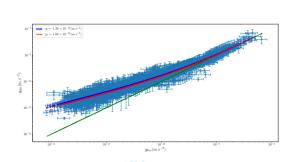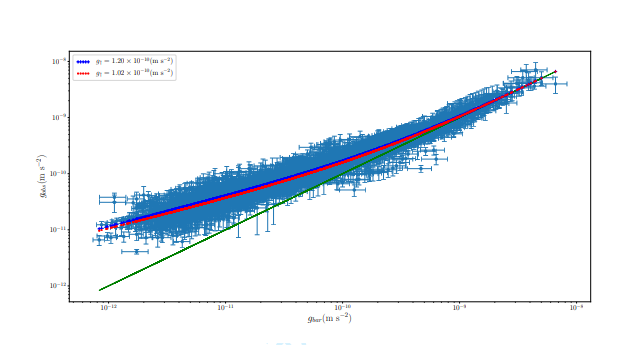|
[1]
|
S. Weinberg, Cosmology, (Oxford, UK:Oxford University Press, 2008) |
|
[2]
|
C. L. Bennett et al (WMAP), Astrophys. J. Suppl., 208:20 (2013) |
|
[3]
|
G. Hinshaw et al (WMAP), Astrophys. J. Suppl., 208:19 (2013) |
|
[4]
|
P. A. R. Ade et al (Planck), Astron. Astrophys., 571:A16 (2014) |
|
[5]
|
P. A. R. Ade et al (Planck), Astron. Astrophys., 594:A13 (2016) |
|
[6]
|
D. Hutsemekers, R. Cabanac, H. Lamy, and D. Sluse, Astron. Astrophys., 441:915 (2005) |
|
[7]
|
A. Kashlinsky, F. Atrio-Barandela, H. Ebeling, A. Edge, and D. Kocevski, Astrophys. J., 712:L81 (2010) |
|
[8]
|
H. A. Feldman, R. Watkins, and M. J. Hudson, Mon. Not. Roy. Astron. Soc., 407:2328 (2010) |
|
[9]
|
J. K. Webb, J. A. King, M. T. Murphy, V. V. Flambaum, R. F. Carswell, and M. B. Bainbridge, Phys. Rev. Lett., 107:191101 (2011) |
|
[10]
|
J. A. King, J. K. Webb, M. T. Murphy, V. V. Flambaum, R. F. Carswell, M. B. Bainbridge, M. R. Wilczynska, and F. E. Koch, Mon. Not. Roy. Astron. Soc., 422:3370 (2012) |
|
[11]
|
A. Mariano and L. Perivolaropoulos, Phys. Rev. D, 86:083517 (2012) |
|
[12]
|
Z. Chang, X. Li, H.-N. Lin, and S. Wang, Eur. Phys. J. C, 74:2821 (2014) |
|
[13]
|
Z. Chang and H.-N. Lin, Mon. Not. Roy. Astron. Soc., 446:2952 (2015) |
|
[14]
|
H.-N. Lin, X. Li, and Z. Chang, Mon. Not. Roy. Astron. Soc., 460:617 (2016) |
|
[15]
|
V. C. Rubin, W. K. Ford, Jr., and N. Thonnard, Astrophys. J., 225:L107 (1978) |
|
[16]
|
A. Bosma, Astron. J., 86:1825 (1981) |
|
[17]
|
A. Tan et al (PandaX-Ⅱ), Phys. Rev. Lett., 117:121303 (2016) |
|
[18]
|
E. Aprile et al (XENON100), Phys. Rev. D, 94:122001 (2016) |
|
[19]
|
M. Milgrom, Astrophys. J., 270:365 (1983) |
|
[20]
|
M. Milgrom, New Astron. Rev., 46:741 (2002) |
|
[21]
|
M. Milgrom, Mon. Not. Roy. Astron. Soc., 437:2531 (2014) |
|
[22]
|
K. G. Begeman, A. H. Broeils, and R. H. Sanders, Mon. Not. Roy. Astron. Soc., 249:523 (1991) |
|
[23]
|
R. A. Swaters, R. H. Sanders, and S. S. McGaugh, Astrophys. J., 718:380 (2010) |
|
[24]
|
Z. Chang, M.-H. Li, X. Li, H.-N. Lin, and S. Wang, Eur. Phys. J. C, 73:2447 (2013) |
|
[25]
|
M. Milgrom, in Proceedings, 2nd International Heidelberg Conference on Dark matter in astrophysics and particle physics (DARK 1998):Heidelberg, Germany, July 20-25, 1998 (1998) p. 443-457 |
|
[26]
|
Y. Zhou, Z.-C. Zhao, and Z. Chang, Astrophys. J., 847:86 (2017) |
|
[27]
|
F. Lelli, S. S. McGaugh, and J. M. Schombert, Astron. J., 152:157 (2016) |
|
[28]
|
S. S. McGaugh, F. Lelli, and J. M. Schombert, Phys. Rev. Lett., 117:201101 (2016) |
|
[29]
|
A. Begum and J. N. Chengalur, Astron. Astrophys., 424:509 (2005) |
|
[30]
|
W. J. G. de Blok, S. S. McGaugh, and J. M. van der Hulst, Mon. Not. Roy. Astron. Soc., 283:18 (1996) |
|
[31]
|
M. Milgrom, (2016), arXiv:1609.06642 |
|
[32]
|
P. T. Boggs, R. H. Byrd, and R. B. Schnabel, SIAM Journal on Scientific and Statistical Computing, 8:1052 (1987) |
|
[33]
|
H. Akaike, IEEE Transactions on Automatic Control, 19:716 (1974) |
|
[34]
|
G. Schwarz, Annals of Statistics, 6:461 (1978) |
|
[35]
|
A. R. Liddle, Mon. Not. Roy. Astron. Soc., 377:L74 (2007) |
|
[36]
|
F. Arevalo, A. Cid, and J. Moya, Eur. Phys. J. C, 77:565 (2017) |
|
[37]
|
H.-N. Lin, X. Li, and Y. Sang, (2017), arXiv:1711.05025 |
|
[38]
|
D. Foreman-Mackey, D. W. Hogg, D. Lang, and J. Goodman, Publications of the Astronomical Society of the Pacific, 125:306 (2013) |
|
[39]
|
W. Zhao, P.-X. Wu, and Y. Zhang, Int. J. Mod. Phys. D, 22:1350060 (2013) |
|
[40]
|
Z. Chang, S. Wang, and X. Li, Eur. Phys. J. C, 72:1838 (2012) |
|
[41]
|
Z. Chang, M.-H. Li, and S. Wang, Phys. Lett. B, 723:257 (2013) |
|
[42]
|
X. Li, H.-N. Lin, S. Wang, and Z. Chang, Eur. Phys. J. C, 75:181 (2015) |
|
[43]
|
J. M. Schombert and S. McGaugh, PASA, 31:e011 (2014) |
|
[44]
|
P.-F. Li, F. Lelli, S. McGaugh, and J. Schormbert, Astron. Astrophys., 615:A3 (2018) |





 Abstract
Abstract HTML
HTML Reference
Reference Related
Related PDF
PDF














 DownLoad:
DownLoad:
